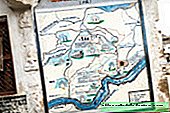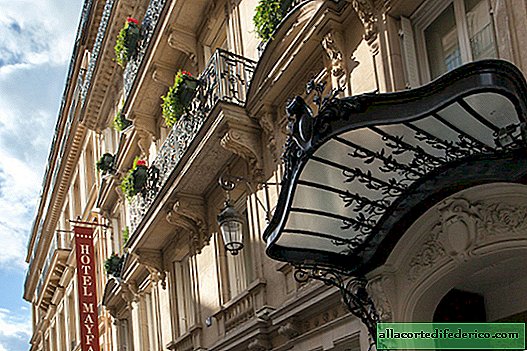Hampi - the ruins of a great empire in the heart of India
If in some countries the sights are drained literally from any old stone, then in India there are no such problems. No matter where you spit, you will find yourself in some ancient temple, palace or city. There are so many ancient ruins here that nobody even pays attention to the small ones. Another thing is something really large and significant !!!
And the ruins of the ancient city of Hampi - just such a case! Huge excavations over an area of more than 30 square meters. km, ancient temples and palaces, history and legends, grandeur and decline ... Hampi is rightly on a par with the main Indian attractions, and you will definitely see his chariot on Indian tourist avenues. So what is this Humpy? What is he so famous for? And what's interesting there?
In fact, Hampi is just a small Indian village located near the ruins of the ancient city of Vijayanagara, which was the capital of the very large and powerful Vijayanagar empire once. The city was very large and at the time of its dawn, in the 15-16 centuries there were about 500 thousand inhabitants, and its area was about 30 square meters. kilometers! They say that in its scope it even surpassed Rome since the heyday of the Roman Empire. But at the end of the 16th century, the empire fell into disrepair, Muslim troops captured the city and almost completely destroyed it, so that from the ancient capital there were only magnificent ruins scattered over a vast territory.
Since 1986, the city of Vijayanagara (under the name of Hampi) has been included in the UNESCO heritage, it is actively excavated and restored, and it is rightfully one of the most interesting historical places in India, but what is India in the world! The excavation area is huge, so on foot you are unlikely to even have time to see its main attractions. It’s better to travel by transport or take a rickshaw, who will also act as a guide).

The most important, oldest and most famous place in Hampi is Virupakshi Temple, from where, as a rule, the visit to the ruins of ancient Vijayanagar begins. The temple is dedicated to Virupaksha - one of the incarnations of the god Shiva, although, by and large, it is just a temple of Shiva.

Many believe that this huge pyramid is the temple (or its roof), but this is not so. This "pyramid" is actually called a gopuram (or gopur), and it is just a gate to the temple. Yes, it’s the gate! And this gate, as a rule, is much more colorful and higher than the Hindu temples themselves! And the meaning of gopuram is that, passing through the gate, you are as if cleansed and you enter the temple with a pure soul.
Gopurams are often replete with statues of all kinds of Hindu deities, and on the gates of Virupaksha you can also see a few scenes of erotic content. This is certainly not a “Kama Sutra temple,” but also quite frankly.

The temple began to be built in the 11-12th centuries, but its present form was formed already in the 15th century. The temple, like the city, was destroyed and plundered by Muslims, and only at the beginning of the 19th century it was restored, and the northern and southern gopurams (gates) were restored. Its territory is huge, and in addition to the temple itself, there is a swimming pool, a kitchen, and chambers, and under the temple flows the Tungabhadra River, which is associated with the wife of Virupaksha - Pampa.

Virupaksha Temple, despite the fact that it is a museum, is operating, and it is one of the most sacred pilgrimage sites for Hindus. There are always a lot of people in this temple, and it’s not tourists but local Hindu pilgrims who come here from all over India.

And the largest gathering of pilgrims can be seen during the Virupaksha and Pampa wedding festival, which takes place in December. What is going on here during the festival is even scary to imagine ... But I’m sure it will be very colorful and very crowded!

And these are the remnants of ancient Jain temples. Little is left of them, alas ...

But the huge statue of Narasimha, another of the incarnations of Vishnu, has been preserved. Either the Muslims felt sorry for her, or she turned out to be too durable and simply could not be destroyed, but she was preserved almost perfectly!

It seems that we are walking along a long stone corridor, but in fact it is an ancient bazaar, shopping malls on which lively trade was conducted only about five hundred years ago. And now this is really just a dead stone tunnel ...

And passing through this long corridor of shopping arcades, we find ourselves in the second most important and famous temple in Hampi - Vithal.

The gopurams in the Vithal temple are made of red stone and once looked monumental and very beautiful. But now we can only admire their lower part, which as a whole has been preserved quite well. Unlike the main temple, this gate has not been restored.

And here, in fact, is the Vithala temple itself, or rather, what is left of it ... Unlike Virupaksha, this temple is not functioning and works only as a museum. Although no one is stopping you from praying, the place is still sacred.

Vithala is not just a temple, but a whole temple complex dedicated to the god Vithal, one of the incarnations of the god Vishnu. In addition to the main temple, there are several buildings for musical, dance and poetry gatherings. Yes, yes, the ancient Indians were very cultured and educated, no worse than in ancient Rome, with whom Hampi is often compared. And where else to dance or sing, if not in the temple? After all, it was the temples that were the place of mass crowds in ancient India.

In one of the halls of the temple complex, we find such columns that for some reason are very, very much jammed. It turns out that these are the famous "musical columns", and they are overwritten because they are constantly played. Although they play, they simply tap, as if on drums. But the columns really sound, and with a certain skill you can even play a melody on them. In total, there are 56 musical columns in the temple, each of which sounds in its own way. You can hear the “music” of the columns either when the wind blows, or tapping on them. Fortunately, only a few columns (these jammed ones) are allocated for the "game", and it is forbidden to even touch the rest! And since everyone can mitigate these, they have already been wiped to blackness)
By the way, there is a belief that those who hear these columns sing will fulfill their most secret desires! Well, what is not an extra reason to come here?

Well, the main symbol of the Vithala temple (and probably all of Hampi) is, of course, the large stone chariot of the god Vishnu. You will see it on all prospectuses, souvenirs and advertising posters dedicated to Hampi, and indeed the sights of southern India. The chariot is really beautiful and unique, and most importantly - it is perfectly preserved!

They bring a chariot, of course, the sacred animals in India - elephants, and they joyfully carry it, although the chariot is many times larger than them.

And her wheels are made in the form of lotus flowers, and the most amazing thing is that they are made just like wheels and spinning, so deeply theoretically this chariot could have gone for real (or maybe it used to go). In India, you can often see such carts during the holidays, so all tourists have this question: "Does this chariot ride?" But no, this one has been standing here for a long time and does not move a centimeter, especially since the wheels were fixed so that tourists would not spin them.

Now, let's go to the so-called royal Hampi area. Here, 500 years ago, the elite of the ancient city lived, the richest Rajas and, of course, the Maharaja with his family. Almost all the houses and royal chambers were destroyed, except for one - the beautiful "Lotus Palace".

This palace in the form of a beautiful Maharaja flower was built for his wife, and Indian and Islamic motifs intertwined in its architecture.

But this is not a palace, as it may seem from afar. Anyway, this building is not for people ... This is a home for elephants!

When I saw this building, in general came in shock! Such a luxury for elephants! Maharaja's lotus palace fades slightly compared to these elephant mansions! This is how in ancient India they worshiped elephants, especially royal ones!

As I said, the territory of Hampi (or rather Vijayanagara) is huge, it is almost impossible to see it all in one day. I saw and showed only its most famous places, and I remember how we drove past many other churches, not even stopping near them. Here, as I know, excavations are still underway, and I think that in the near future many more interesting things will be excavated. So do not miss this unique place, especially from Goa to Hampi is not so far)

















